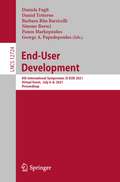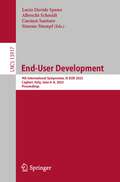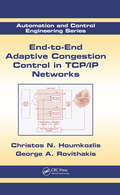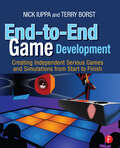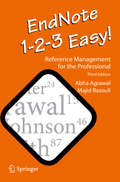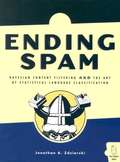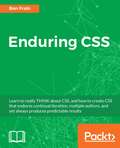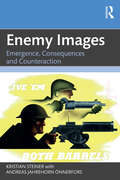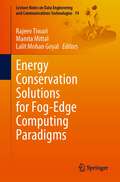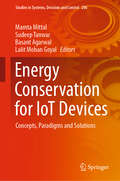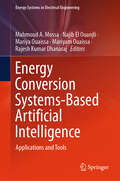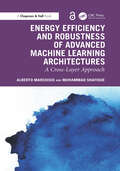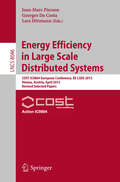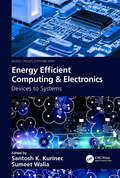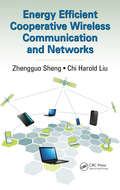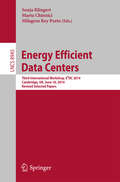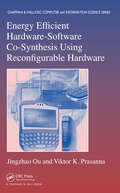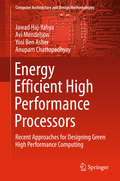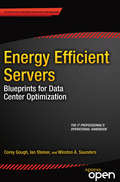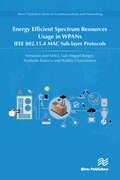- Table View
- List View
End-User Development: 8th International Symposium, IS-EUD 2021, Virtual Event, July 6–8, 2021, Proceedings (Lecture Notes in Computer Science #12724)
by Panos Markopoulos Barbara Rita Barricelli George A. Papadopoulos Simone Borsci Daniela Fogli Daniel TetterooThis book constitutes the proceedings of the 8th International Conference on End-User Development, IS-EUD 2021, held in July 2021. Due to COVID-19 pandemic the conference was held virtually.The paper track received 26 submissions, of which 11 full and 4 short papers were selected after a rigorous double-blind review process. The papers focus on “Democratizing AI development”, namely on EUD for AI-based systems, where end users are called-on to become end-user developers of intelligent agents, digital twins, collaborative systems and social robots.
End-User Development: 9th International Symposium, IS-EUD 2023, Cagliari, Italy, June 6–8, 2023, Proceedings (Lecture Notes in Computer Science #13917)
by Albrecht Schmidt Simone Stumpf Lucio Davide Spano Carmen SantoroThis book constitutes the refereed proceedings of the 9th International Symposium on End-User Development, IS-EUD 2023, held in Cagliari, Italy, during June 6–8, 2023.The 17 full papers and 2 (keynote extended abstracts) included in this book were carefully reviewed and selected from 26 submissions. They were organized in topical sections as follows: Artificial Intelligence for End-Users; Internet of Things for End-Users; Privacy; Security and Society; Supporting End-User Development.
End-to-End Adaptive Congestion Control in TCP/IP Networks (Automation and Control Engineering #46)
by Christos N. Houmkozlis George A. RovithakisEstablishing adaptive control as an alternative framework to design and analyze Internet congestion controllers, End-to-End Adaptive Congestion Control in TCP/IP Networks employs a rigorously mathematical approach coupled with a lucid writing style to provide extensive background and introductory material on dynamic systems stability and neural network approximation; alongside future internet requests for congestion control architectures. Designed to operate under extreme heterogeneous, dynamic, and time-varying network conditions, the developed controllers must also handle network modeling structural uncertainties and uncontrolled traffic flows acting as external perturbations. The book also presents a parallel examination of specific adaptive congestion control, NNRC, using adaptive control and approximation theory, as well as extensions toward cooperation of NNRC with application QoS control. Features: Uses adaptive control techniques for congestion control in packet switching networks Employs a rigorously mathematical approach with lucid writing style Presents simulation experiments illustrating significant operational aspects of the method; including scalability, dynamic behavior, wireless networks, and fairness Applies to networked applications in the music industry, computers, image trading, and virtual groups by techniques such as peer-to-peer, file sharing, and internet telephony Contains working examples to highlight and clarify key attributes of the congestion control algorithms presented Drawing on the recent research efforts of the authors, the book offers numerous tables and figures to increase clarity and summarize the algorithms that implement various NNRC building blocks. Extensive simulations and comparison tests analyze its behavior and measure its performance through monitoring vital network quality metrics. Divided into three parts, the book offers a review of computer networks and congestion control, presents an adaptive congestion control framework as an alternative to optimization methods, and provides appendices related to dynamic systems through universal neural network approximators.
End-to-End Game Development: Creating Independent Serious Games and Simulations from Start to Finish
by Nick Iuppa Terry BorstYou're part of a new venture, an independent gaming company, and you are about to undertake your first development project. The client wants a serious game, one with instructional goals and assessment metrics. Or you may be in a position to green light such a project yourself, believing that it can advance your organization's mission and goals. This book provides a proven process to take an independent game project from start to finish. In order to build a successful game, you need to wear many hats. There are graphic artists, software engineers, designers, producers, marketers - all take part in the process at various (coordinated) stages, and the end result is hopefully a successful game. Veteran game producers and writers (Iuppa and Borst) cover all of these areas for you, with step by step instructions and checklists to get the work done.The final section of the book offers a series of case studies from REAL indy games that have been developed and launched succesfully, and show exactly how the principles outlined in the book can be applied to real world products. The book's associated author web site offers ancillary materials & references as well as serious game demos and presentations.
End-to-End Web Testing with Cypress: Explore techniques for automated frontend web testing with Cypress and JavaScript
by Waweru MwauraGet to grips with the Cypress framework and learn how to best implement end-to-end automation testing with JavaScript with the help of expert tips, best practices, and real-world testing examplesKey FeaturesWrite your first end-to-end test and find out how to modernize your testing environmentExecute test-driven web development and cross-browser testing using CypressDiscover the advantages of using Cypress over Selenium and refactor testing for modern web appsBook DescriptionCypress is a modern test automation framework for web-based frontend apps. Learning Cypress will help you overcome the shortcomings of conventional testing solutions such as dependency graph problems, the steep learning curve in setting up end-to-end testing packages, and difficulties in writing explicit time waits for your tests. In End-to-End Web Testing with Cypress, you'll learn how to use different Cypress tools, including time travel, snapshots, errors, and console output, to write fail-safe and non-flaky tests. You'll discover techniques for performing test-driven development (TDD) with Cypress and write cross-browser tests for your web applications. As you advance, you'll implement tests for a sample application and work with a variety of tools and features within the Cypress ecosystem. Finally, this Cypress book will help you grasp advanced testing concepts such as visual testing and networking. By the end of this book, you'll have the skills you need to be able to set up Cypress for any web app and understand how to use it to its full potential.What you will learnGet to grips with Cypress and understand its advantages over SeleniumExplore common Cypress commands, tools, and techniques for writing complete tests for web appsSet up and configure Cypress for cross-browser testingUnderstand how to work with elements and animation to write non-flaky testsDiscover techniques for implementing and handling navigation requests in testsImplement visual regression tests with Applitools eyesWho this book is forThis book is for automation testing professionals, software and web testers, and frontend web developers who have intermediate-level JavaScript and beginner-level test automation knowledge, as well as for complete beginners who are looking to get started with Cypress and learn how it works. You'll also find this book useful if you are a Selenium tester who wants to migrate to Cypress and leverage its capabilities. An intermediate-level understanding of JavaScript programming and beginner-level knowledge of web testing are required.
EndNote 1-2-3 Easy!: Reference Management for the Professional
by Abha Agrawal Majid RasouliThis book is intended for healthcare professionals, biomedical researchers, health policy experts, and graduate students who frequently write and publish scientific manuscripts in peer reviewed journals. This new edition updates earlier versions with an emphasis on the most currently available Clarivate Analytics software application EndNote X9, a widely used reference management software. For first-time users of EndNote X9, this book is a comprehensive and well-illustrated instruction manual for getting started, including detailed instructions on installation, creating reference libraries, and ultimately creating complete and accurate citation-based bibliographies necessary to achieve successful peer reviewed publications. There is also a full chapter devoted to careful guidance for the growing practice of citing references from online internet sources. For existing “power users” of current and earlier versions of EndNote, this book provides quick and easy access to a comprehensive compendium of nuanced and advanced features of this powerful software, with an emphasis on providing greater ease and control in coordinating and curating research materials and bibliographies with research collaborators and scientific writing teams. The authors have also added new, state-of-the-art “how-to” guidance on a variety of methods of using EndNote, including PubMed, Google Scholar, Web of Science, Scopus and others. Like many legacy software systems, Clarivate Analytics has also begun to offer an online “desktop” version of EndNote, a topic which is now also covered in Chapter 10 (EndNote Online) of this new edition.
Ending Spam
by Jonathan A. ZdziarskiJoin author John Zdziarski for a look inside the brilliant minds that have conceived clever new ways to fight spam in all its nefarious forms. This landmark title describes, in-depth, how statistical filtering is being used by next-generation spam filters to identify and filter unwanted messages, how spam filtering works and how language classification and machine learning combine to produce remarkably accurate spam filters. After reading Ending Spam , you'll have a complete understanding of the mathematical approaches used by today's spam filters as well as decoding, tokenization, various algorithms (including Bayesian analysis and Markovian discrimination) and the benefits of using open-source solutions to end spam. Zdziarski interviewed creators of many of the best spam filters and has included their insights in this revealing examination of the anti-spam crusade. If you're a programmer designing a new spam filter, a network admin implementing a spam-filtering solution, or just someone who's curious about how spam filters work and the tactics spammers use to evade them, Ending Spam will serve as an informative analysis of the war against spammers. TOC Introduction PART I: An Introduction to Spam Filtering Chapter 1: The History of Spam Chapter 2: Historical Approaches to Fighting Spam Chapter 3: Language Classification Concepts Chapter 4: Statistical Filtering Fundamentals PART II: Fundamentals of Statistical Filtering Chapter 5: Decoding: Uncombobulating Messages Chapter 6: Tokenization: The Building Blocks of Spam Chapter 7: The Low-Down Dirty Tricks of Spammers Chapter 8: Data Storage for a Zillion Records Chapter 9: Scaling in Large Environments PART III: Advanced Concepts of Statistical Filtering Chapter 10: Testing Theory Chapter 11: Concept Identification: Advanced Tokenization Chapter 12: Fifth-Order Markovian Discrimination Chapter 13: Intelligent Feature Set Reduction Chapter 14: Collaborative Algorithms Appendix: Shining Examples of Filtering Index
Enduring CSS
by Ben FrainLearn to really THINK about CSS, and how to create CSS that endures continual iteration, multiple authors, and yet always produces predictable results About This Book • Address the problems of CSS at scale, avoiding the shortfalls of scaling CSS. • The shortfalls of conventional approaches to scaling CSS. • Develop consistent and enforceable selector naming conventions with ECSS. • Learn how to organize project structure to more easily isolate and decouple visual components. Who This Book Is For This is a book for working CSS authors involved in large projects. This is a book that tackles create enduring CSS for large-scale projects. What You Will Learn • The problems of CSS at scale—specificity, the cascade and styles intrinsically tied to element structure. • The shortfalls of conventional approaches to scaling CSS. • The ECSS methodology and the problems it solves. • How to develop consistent and enforceable selector naming conventions with ECSS. • How to organise project structure to more easily isolate and decouple visual components. • How to handle state changes in the DOM with ARIA or override selectors. • How to apply ECSS to web applications and visual modules. • Considerations of CSS tooling and processing: Sass/PostCSS and linting. • Addressing the notion of CSS selector speed with hard data and browser representative insight In Detail Learn with me, Ben Frain, about how to really THINK about CSS and how to use CSS for any size project! I'll show you how to write CSS that endures continual iteration, multiple authors, and yet always produces predictable results. Enduring CSS, often referred to as ECSS, offers you a robust and proven approach to authoring and maintaining style sheets at scale. Enduring CSS is not a book about writing CSS, as in the stuff inside the curly braces. This is a book showing you how to think about CSS, and be a smarter developer with that thinking! It's about the organisation and architecture of CSS—the parts outside the braces. I will help you think about the aspects of CSS development that become the most difficult part of writing CSS in larger projects. You'll learn about the problems of authoring CSS at scale—including specificity, the cascade and styles intrinsically tied to document structure. I'll introduce you to the ECSS methodology, and show you how to develop consistent and enforceable selector naming conventions. We'll cover how to apply ECSS to your web applications and visual model, and how you can organize your project structure wisely, and handle visual state changes with ARIA, providing greater accessibility considerations. In addition, we'll take a deep look into CSS tooling and process considerations. Finally we will address performance considerations by examining topics such as CSS selector speed with hard data and browser-representative insight. Style and approach Learn with me, Ben Frain, about how to really think about CSS. This is a book to deal with writing CSS for large-scale, rapidly changing web projects and applications. This isn't a book about writing CSS, as in the stuff inside the curly braces - this is a book about the organisation and architecture of CSS; the parts outside the braces!
Enemy Images: Emergence, Consequences and Counteraction
by Kristian Steiner Andreas ÖnnerforsThis book offers a detailed understanding of ‘enemy images’, which are used in political rhetoric to dehumanize adversaries for various purposes, such as to legitimate violent conflicts.Applying theoretical models to a strong catalogue of historical and recent examples – from blood libel narratives in medieval manuscripts, to state-sponsored children’s board games in Nazi Germany and social media posts about the wars in Gaza and Ukraine – the book identifies how ‘enemy images’ have led to the development of dominant socio-political paradigms by providing justifications for and reinforcements of violent conflicts both within and between societies. In doing so, the work offers an up-to-date, accessible and authoritative overview of how to identify, analyse, and counteract energy images – which will be key to fostering social environments of reconciliation and peacebuilding for the future.This book will be of much interest to students and scholars of peace and conflict studies, International Relations, history, political sociology, and communication studies.
Energy Conservation Solutions for Fog-Edge Computing Paradigms (Lecture Notes on Data Engineering and Communications Technologies #74)
by Mamta Mittal Lalit Mohan Goyal Rajeev TiwariThis book focuses on energy efficiency concerns in fog–edge computing and the requirements related to Industry 4.0 and next-generation networks like 5G and 6G. This book guides the research community about practical approaches, methodological, and moral questions in any nations’ journey to conserve energy in fog–edge computing environments. It discusses a detailed approach required to conserve energy and comparative case studies with respect to various performance evaluation metrics, such as energy conservation, resource allocation strategies, task allocation strategies, VM migration, and load-sharing strategies with state-of-the-art approaches, with fog and edge networks.
Energy Conservation for IoT Devices: Concepts, Paradigms and Solutions (Studies in Systems, Decision and Control #206)
by Basant Agarwal Mamta Mittal Lalit Mohan Goyal Sudeep TanwarThis book addresses the Internet of Things (IoT), an essential topic in the technology industry, policy, and engineering circles, and one that has become headline news in both the specialty press and the popular media. The book focuses on energy efficiency concerns in IoT and the requirements related to Industry 4.0. It is the first-ever “how-to” guide on frequently overlooked practical, methodological, and moral questions in any nations’ journey to reducing energy consumption in IoT devices. The book discusses several examples of energy-efficient IoT, ranging from simple devices like indoor temperature sensors, to more complex sensors (e.g. electrical power measuring devices), actuators (e.g. HVAC room controllers, motors) and devices (e.g. industrial circuit-breakers, PLC for home, building or industrial automation). It provides a detailed approach to conserving energy in IoT devices, and comparative case studies on performance evaluation metrics, state-of-the-art approaches, and IoT legislation.
Energy Conversion Systems-Based Artificial Intelligence: Applications and Tools (Energy Systems in Electrical Engineering)
by Mariya Ouaissa Mariyam Ouaissa Rajesh Kumar Dhanaraj Mahmoud A. Mossa Najib El OuanjliThis book aims to propose advanced solutions based on artificial intelligence techniques for ECS in order to increase energy efficiency, ensure the safety of the ECS, and to improve the quality of the energy supplied to the grid. The efficiency and quality of the electrical energy produced depends mainly on the structure and efficiency of the control technology developed for the Energy Conversion System (ECS). To improve the performance of ECSs, it is interesting to design control systems that emulate some functions performed by the human brain. Among these interesting functions are self-adaptation, learning, flexibility of operation and planning in the presence of large uncertainties and with minimal information. Based on these aspects, artificial intelligence (AI) techniques can be developed and applied to solve the different control problems of ECSs. For academics, professionals, practitioners, and graduate students interested in the most recent research on the application of AI in ECS, it is the ideal reference source.
Energy Efficiency and Robustness of Advanced Machine Learning Architectures: A Cross-Layer Approach (Chapman & Hall/CRC Artificial Intelligence and Robotics Series)
by Alberto Marchisio Muhammad ShafiqueMachine Learning (ML) algorithms have shown a high level of accuracy, and applications are widely used in many systems and platforms. However, developing efficient ML-based systems requires addressing three problems: energy-efficiency, robustness, and techniques that typically focus on optimizing for a single objective/have a limited set of goals.This book tackles these challenges by exploiting the unique features of advanced ML models and investigates cross-layer concepts and techniques to engage both hardware and software-level methods to build robust and energy-efficient architectures for these advanced ML networks. More specifically, this book improves the energy efficiency of complex models like CapsNets, through a specialized flow of hardware-level designs and software-level optimizations exploiting the application-driven knowledge of these systems and the error tolerance through approximations and quantization. This book also improves the robustness of ML models, in particular for SNNs executed on neuromorphic hardware, due to their inherent cost-effective features. This book integrates multiple optimization objectives into specialized frameworks for jointly optimizing the robustness and energy efficiency of these systems.This is an important resource for students and researchers of computer and electrical engineering who are interested in developing energy efficient and robust ML.The Open Access version of this book, available at http://www.taylorfrancis.com, has been made available under a Creative Commons Attribution-Non Commercial-No Derivatives (CC-BY-NC-ND) 4.0 license.
Energy Efficiency in Large Scale Distributed Systems
by Lars Dittmann Jean-Marc Pierson Georges Da CostaThis book constitutes revised selected papers from the Conference on Energy Efficiency in Large Scale Distributed Systems, EE-LSDS, held in Vienna, Austria, in April 2013. It served as the final event of the COST Action IC0804 which started in May 2009. The 15 full papers presented in this volume were carefully reviewed and selected from 31 contributions. In addition, 7 short papers and 3 demo papers are included in this book. The papers are organized in sections named: modeling and monitoring of power consumption; distributed, mobile and cloud computing; HPC computing; wired and wireless networking; and standardization issues.
Energy Efficiency: Real Time Energy Infrastructure Investment and Risk Management
by Leslie A. SolmesENERGY EFFICIENCY uses an applied scientific methodology and case studies to demonstrate and support: The need for the U.S. and the world to commit to energy and resource efficiency as the central goal in investing in electric, heat, and cooling infrastructure, the huge economic opportunity for using the inefficiency built into 20th century energy supply systems, especially, electric, to pay for the upgrades, replacements, and new production and distribution systems of the 21st century, the importance of adopting a standard, web-based energy infrastructure investment decision-making and risk management tool that will serve as a communication medium for all stakeholders to evaluate and compare energy infrastructure investment options and manage investment risks, expansions of the U.S. 'smart' grid investment to include evaluation and risk management of energy systems infrastructure investments not just electricity operations, the need to adopt a 'framework' for utilities, energy service companies, and customers to work together to close business deals, communicate and manage risks, and realize profits.
Energy Efficient Computation Offloading in Mobile Edge Computing (Wireless Networks)
by Ying Chen Ning Zhang Yuan Wu Sherman ShenThis book provides a comprehensive review and in-depth discussion of the state-of-the-art research literature and propose energy-efficient computation offloading and resources management for mobile edge computing (MEC), covering task offloading, channel allocation, frequency scaling and resource scheduling. Since the task arrival process and channel conditions are stochastic and dynamic, the authors first propose an energy efficient dynamic computing offloading scheme to minimize energy consumption and guarantee end devices’ delay performance. To further improve energy efficiency combined with tail energy, the authors present a computation offloading and frequency scaling scheme to jointly deal with the stochastic task allocation and CPU-cycle frequency scaling for minimal energy consumption while guaranteeing the system stability. They also investigate delay-aware and energy-efficient computation offloading in a dynamic MEC system with multiple edge servers, and introduce an end-to-end deep reinforcement learning (DRL) approach to select the best edge server for offloading and allocate the optimal computational resource such that the expected long-term utility is maximized. Finally, the authors study the multi-task computation offloading in multi-access MEC via non-orthogonal multiple access (NOMA) and accounting for the time-varying channel conditions. An online algorithm based on DRL is proposed to efficiently learn the near-optimal offloading solutions.Researchers working in mobile edge computing, task offloading and resource management, as well as advanced level students in electrical and computer engineering, telecommunications, computer science or other related disciplines will find this book useful as a reference. Professionals working within these related fields will also benefit from this book.
Energy Efficient Computing & Electronics: Devices to Systems (Devices, Circuits, and Systems)
by Krzysztof Iniewski, Santosh K. Kurinec and Sumeet WaliaIn our abundant computing infrastructure, performance improvements across most all application spaces are now severely limited by the energy dissipation involved in processing, storing, and moving data. The exponential increase in the volume of data to be handled by our computational infrastructure is driven in large part by unstructured data from countless sources. This book explores revolutionary device concepts, associated circuits, and architectures that will greatly extend the practical engineering limits of energy-efficient computation from device to circuit to system level. With chapters written by international experts in their corresponding field, the text investigates new approaches to lower energy requirements in computing. Features • Has a comprehensive coverage of various technologies • Written by international experts in their corresponding field • Covers revolutionary concepts at the device, circuit, and system levels
Energy Efficient Cooperative Wireless Communication and Networks
by Zhengguo Sheng Chi Harold LiuCompared with conventional communications, cooperative communication allows multiple users in a wireless network to coordinate their packet transmissions and share each other's resources, thus achieving high-performance gain and better service coverage and reliability. Energy Efficient Cooperative Wireless Communication and Networks provides a comp
Energy Efficient Data Centers
by Sonja Klingert Marta Chinnici Milagros Rey PortoThis book constitutes the thoroughly refereed post-conference proceedings of the Third International Workshop on Energy Efficient Data Centers, E2DC 2014, held in Cambridge, UK, in June 2014. The 10 revised full papers presented were carefully selected from numerous submissions. They are organized in three topical sections named: energy optimization algorithms and models, the future role of data centres in Europe and energy efficiency metrics for data centres.
Energy Efficient Full Duplex Wireless Communication Systems (Wireless Networks)
by Xu Zhu Jingjing Wang Zhongxiang Wei Sumei SunIn an effort to overcome the spectral efficiency loss and high latency by half-duplex (HD), full-duplex (FD) has attracted extensive attention in industry and academia. With signal transmitted and received simultaneously over the same frequency, FD can approximately double the SE over HD. More than that, by enabling the capability of simultaneous transmission-and-reception for communication nodes, full duplex (FD) is a key enabler for many 5G techniques, including but not limited to integrated sensing and communication, low-latency relaying, concurrent bi-directional uplink and downlink transmission, ect. Nevertheless, in FD communications, both transmit and receive radio frequency (RF) chains are activated for exchanging data, and additional power is triggered by self-interference cancellation. As FD requires much higher power consumption than that of half duplex (HD), it is against the green evolution requirement proposed by the future communication systems. To address the critical high-power challenge in applying FD communications, this book will introduce the fundamentals and algorithm designs for energy-efficient FD design. This book will first discuss the principle of energy-efficient communications, which aims to make a good balance between communication performance and system energy consumption. Then, this book will discuss different self-interference cancellation schemes, including passive suppression, analogue cancellation and digital cancellation for FD communications, from the prospective of energy efficiency. Subsequently, this book will present some edge-cutting energy efficiency-oriented FD solutions, including adaptive transmission power adaptation, wireless power transfer FD relaying, bi-directional FD distributed antenna systems, from the perspective of algorithm design and performance analysis.
Energy Efficient Hardware-Software Co-Synthesis Using Reconfigurable Hardware (Chapman & Hall/CRC Computer and Information Science Series)
by Viktor K. Prasanna Jingzhao OuRapid energy estimation for energy efficient applications using field-programmable gate arrays (FPGAs) remains a challenging research topic. Energy dissipation and efficiency have prevented the widespread use of FPGA devices in embedded systems. Helping overcome these challenges, this book offers solutions for the development of energy efficient applications using FPGAs. It provides a framework for high-level hardware-software application development, describes energy performance modeling for reconfigurable system-on-chip devices, and explores energy efficient designs for various applications. The authors present a two-step rapid energy estimation technique that enables high-level design space exploration and offer a hardware-software design for energy efficient implementations of operating systems.
Energy Efficient High Performance Processors: Recent Approaches For Designing Green High Performance Computing (Computer Architecture and Design Methodologies)
by Anupam Chattopadhyay Jawad Haj-Yahya Avi Mendelson Yosi Ben AsherThis book explores energy efficiency techniques for high-performance computing (HPC) systems using power-management methods. Adopting a step-by-step approach, it describes power-management flows, algorithms and mechanism that are employed in modern processors such as Intel Sandy Bridge, Haswell, Skylake and other architectures (e.g. ARM). Further, it includes practical examples and recent studies demonstrating how modem processors dynamically manage wide power ranges, from a few milliwatts in the lowest idle power state, to tens of watts in turbo state. Moreover, the book explains how thermal and power deliveries are managed in the context this huge power range. The book also discusses the different metrics for energy efficiency, presents several methods and applications of the power and energy estimation, and shows how by using innovative power estimation methods and new algorithms modern processors are able to optimize metrics such as power, energy, and performance. Different power estimation tools are presented, including tools that break down the power consumption of modern processors at sub-processor core/thread granularity. The book also investigates software, firmware and hardware coordination methods of reducing power consumption, for example a compiler-assisted power management method to overcome power excursions. Lastly, it examines firmware algorithms for dynamic cache resizing and dynamic voltage and frequency scaling (DVFS) for memory sub-systems.
Energy Efficient Servers: Blueprints for Data Center Optimization
by Corey Gough Ian Steiner Winston SaundersEnergy Efficient Servers: Blueprints for Data Center Optimization introduces engineers and IT professionals to the power management technologies and techniques used in energy efficient servers. The book includes a deep examination of different features used in processors, memory, interconnects, I/O devices, and other platform components. It outlines the power and performance impact of these features and the role firmware and software play in initialization and control. Using examples from cloud, HPC, and enterprise environments, the book demonstrates how various power management technologies are utilized across a range of server utilization. It teaches the reader how to monitor, analyze, and optimize their environment to best suit their needs. It shares optimization techniques used by data center administrators and system optimization experts at the world's most advanced data centers. What you'll learn * Develop a deep understanding of power management in modern servers - from data center and systems software to low-level processor technologies - and all the pieces in-between. * Build an understanding of technologies used in cores, caches, memory, system agents, processor interconnects, and PCI-E to manage power. * Learn techniques for monitoring and characterizing server power management technologies including component and system level impact. * Develop strategies to improve infrastructure utilization and cost-effectiveness, to guide configuration and purchasing decisions, and to enhance application deployment. * Learn new techniques to optimize a server for energy efficiency while still meeting the service level requirements of software, related systems in the data center, and end customers. Who this book is for Primarily: Engineers and IT professionals. More broadly, the book appeals to a wide technologist audience - anyone who designs or relies on a server to run services and applications - from software engineers, to system administrators, to equipment and system manufacturers, to data center operators. Table of Contents Foreword/Preface Chapter 1: Why Data Center Efficiency Matters Chapter 2: CPU and Memory Power Management Chapter 3: Memory and I/O Power Management Chapter 4: Software Architecture Chapter 5: BIOS and Management Firmware Chapter 6: Operating Systems Chapter 7: Monitoring Chapter 8: Characterization and Optimization Chapter 9: Data Center Management Chapter 10: Terms and Technology Appendix
Energy Efficient Smart Phones for 5G Networks
by Jonathan Rodriguez Ayman RadwanThis book addresses current technology trends and requirements leading towards the next era in mobile communication handsets; and beyond that the book proposes innovative solutions that could be candidate solutions for 5G phones. It adopts a multidisciplinary and interdisciplinary stance towards handset design, a necessary ingredient if 5th Generation handset and services are to really take-off. Therefore the scope of the book targets a broad range of subjects, including energy efficiency, RF design, cooperation, context-aware systems, roaming, and short-range networking, all of which working in synergy to provide seamless mobility and high speed connectivity within a HetNet environment. Specifically, the authors investigate how we can exploit the cooperation paradigm and context-aware mechanism working in synergy to provide energy compliant phones that can introduce power savings of up to 50% on state-of-the-art. Going beyond this, a chapter on business modeling approaches is also included, based on incentive mechanisms for cooperation that will provide the necessary leverage to promote the up-take of the proposed technology.
Energy Efficient Spectrum Resources Usage in WPANs: IEEE 82.15.4 MAC Sub-layer Protocols (River Publishers Series in Communications and Networking)
by Periklis Chatzimisios Luís Miguel Borges Norberto Barroca Fernando José VelezWireless Sensor Networks (WSNs) and the Internet of Things are facing tremendous advances both in terms of energy-efficiency as well as in the number of available applications. Consequently, there are challenges that need to be tackled for the future generation of WSNs. After giving an overview of the WSN protocols and IEEE 802.15.4 standard, this book proposes IEEE 802.15.4 Medium Access Control (MAC) sub-layer performance enhancements by employing not only RTS/CTS combined with packet concatenation but also scheduled channel poling (MC-SCP). Results have shown that the use of the RTS/CTS mechanism improves channel efficiency by decreasing the deferral time before transmitting a data packet. Furthermore, the Sensor Block Acknowledgment MAC (SBACK-MAC) protocol enables more efficiency as it allows the aggregation of several acknowledgement responses in one special Block Acknowledgment (BACK) Response packet. The throughput and delay performance have been mathematically derived under both ideal conditions (a channel environment with no transmission errors) and non-ideal conditions (with transmission errors). Simulation results successfully validate the proposed analytical models. This research reveals the importance of an appropriate design for the MAC sub-layer protocol for the desired WSN application. Depending on the mission of the WSN application, different protocols are required. Therefore, the overall performance of a WSN application certainly depends on the development and application of suitable e.g., MAC, network layer protocols.
